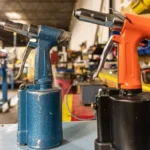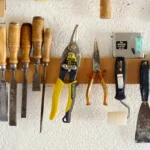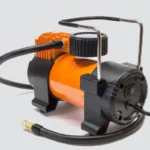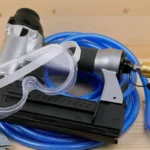Have you ever wondered how these tools manage to accomplish so much with nothing but air? From inflating tires to powering jackhammers, pneumatic tools are the unsung heroes of the tool world, and understanding how they work not only satisfies curiosity but also enhances the efficiency and safety of their use.
Historical Context and Evolution
Pneumatic technology isn’t a new kid on the block. Its roots stretch back to ancient civilizations, but it truly came into its own during the industrial revolution. Imagine a time when the buzz and clatter of machinery became the backdrop of progress—this was the era when pneumatic tools began replacing their manual and electric predecessors. Why? They brought a new level of safety and efficiency to the workshop floor. They were, and still are, a breath of fresh air in industrial innovation, transforming mundane tasks into feats of engineering with each squeeze of the trigger.
Core Principles of Pneumatic Systems
At its core, the concept of a pneumatic tool is beautifully straightforward: use air, pressurize it, and then harness this power to do the heavy lifting. Let’s break it down:
The Role of Air Compressors
The heart of any pneumatic system is the air compressor, a device that takes in ambient air and squeezes it into a much smaller volume at high pressure. Think of it as a balloon that you can inflate and deflate at will, but instead of rubber, you have a metal tank, and instead of your lungs, there’s a powerful mechanical pump. This compressed air is not just any air—it’s potential energy waiting to be unleashed.
Air compressors come in various shapes and sizes, each tailored to a specific job. Whether it’s a piston compressor thumping away to create pressure or a rotary screw compressor spinning silently, the goal is the same: convert electrical energy into pneumatic energy.
From Compressed Air to Power
Once compressed, this air travels through hoses to reach its destination—the pneumatic tool itself. Here’s where the magic happens. Inside each tool is a pneumatic motor, which might be a vane, piston, or turbine type. Each type has its specialty, like the vane motor with its low-speed, high-torque output perfect for heavy-duty drilling or the turbine motor’s high-speed finesse ideal for precision painting.
The air’s journey doesn’t stop at the motor. It moves into the tool’s business end, pushing against pistons or spinning vanes to create the mechanical motion that does the actual work, be it turning a screw or chiseling through concrete.
Components of Pneumatic Tools
Valves and Pistons
Each pneumatic tool houses a sophisticated dance between valves and pistons, orchestrated to optimize the power of compressed air. Valves act like traffic cops, directing the flow of air into the pistons. As air pressure builds, the pistons spring into action—moving back and forth or spinning based on the tool’s requirements. This action is what turns potential energy into the mechanical force that powers the business end of a tool, whether it’s hammering, cutting, or drilling.
Keeping Everything in Check
The synchronization between the valve opening and piston movement is critical. In a pneumatic hammer, for example, the valve’s release allows air to propel the piston forward to strike with immense force. Once the blow is delivered, the valve closes, allowing the piston to retract and prepare for the next strike. This precise control over air flow and pressure not only maximizes efficiency but also extends the tool’s lifespan by reducing wear and tear.
Common Pneumatic Air Tools and Their Mechanics
Pneumatic tools are not just varied in type but specialized in function. Here are a few champions of the air tool world:
- Air Drills: These are the workhorses of the pneumatic arsenal, utilizing the rotary motion generated by air pressure to drill holes or drive screws seamlessly.
- Pneumatic Hammers: Known for their brute force, these tools use rapid, repetitive piston movements to deliver powerful blows—ideal for breaking up concrete or other tough materials.
- Air Wrenches: Leveraging the torque generated by compressed air, these tools make quick work of tightening or loosening bolts, providing a level of torque manual wrenches could only dream of.
Advantages Over Electric Tools
Safety First
One of the standout benefits of pneumatic tools is their inherent safety. Without the risk of sparks or electrical faults, these tools are lifesavers in environments where flammable gases or dust could pose a risk.
Power Meets Efficiency
Not only do air tools pack a powerful punch, but they also do so with remarkable efficiency. The consistent force provided by compressed air means these tools maintain their peak performance for the duration of their use, without the power dips associated with battery-operated tools.
Versatility in Harsh Environments
Whether it’s a damp construction site or a dusty workshop, pneumatic tools are unfazed. Their simplicity and the non-reliance on electrical components allow them to operate in places where electric tools would falter.
Why Choose Pneumatic?
Using pneumatic tools means more than just utilizing another piece of equipment. It’s about choosing tools that offer reliability, safety, and efficiency—qualities that are paramount in any professional setting. Whether you’re a weekend warrior looking to upgrade your garage setup or a seasoned pro on the construction site, pneumatic tools offer a compelling array of benefits that make them indispensable in the tool world.

Matthew Dowell
Matthew, a seasoned builder from a family of craftsmen, leads Tools Trove. His passion for tools and decades of hands-on experience fuel his commitment to providing expert reviews and insightful content. Whether you’re a pro or a DIY enthusiast, Matthew’s guidance ensures informed decisions in the world of tools.




